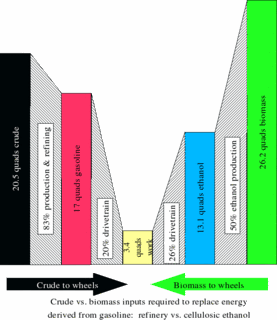This a Lazy Comment Essay, where I copy a comment from elsewhere as a short essay.
This comment is in response to a comment thread in my own diary on the Big Orange (posted here first), The Next Economic Revolution: Economic Growth and the Steady State.
paul2port says:
Regarding energy
Wood, followed by coal, followed by oil followed by….Energy specialists seem to think the next sustainable energy economy will be — hydrogen.
There needs to be a lot of innovation and breaking down of the old established system to replace oil.
It can’t come too soon, as far as I am concerned. …
And then after a round where I demur and raise some issues and he answers and I demur again, says:
The elegant solution might involve that tricky, tiny atom, hydrogen. Let’s put aside the political aspects your quite correctly identify, just for a moment. It might work someday.
In the meantime I’m all in favor of some inelegant kludge. If solar photovoltaics come down in price there will be a point where you won’t care if they’re only 20-30% efficient. There’s so much solar energy hitting the earth that they’ll simply be everywhere.
My Lazy Comment Essay, after the Fold.
Ah … hidden somewhere in the … (0 / 0)
… premises of the diary … or perhaps different expressions of some of the same ideas … is the idea that “one size fits all” never fits everyone, and never fits a majority well.
The hydrogen economy vision is an attempt to find the fuel to recreate the one-size-fits-all system on a sustainable basis … that is, sustainable electricity, sustainable biomass, everything channels into making hydrogen, and a hydrogen fuel distribution system allows a wide range of fixed and mobile power users to tap into that source.
That intrinsically costs energy, in the extra conversion steps required to get from wherever you start to the one-size-fits-all fuel source. However, as engineer poet notes, paying attention to reducing conversion steps can yield big benefits in terms of the energy yield of sustainable power sources.
For example, here is what conversion efficiencies mean with respect to getting power to the drive-train of a vehicle with cellulosic ethanol:

… and hydrogen conversion efficiencies are lower than that.
So I do not look on a variety of distribution networks … biocoal on electric freight rail, wind and solar power over the local HVAC and regional HVDC grids, biodiesel and ethanol in tank containers by rail and local truck to the dispersed locations that require portable liquid fuels … as a kludge. I look on it as part of the new paradigm … tailoring efficient solutions to specific problems, as opposed to one-size-fits-all.

30 comments
Skip to comment form
Author
… collected and cunningly disguised as a diary on the Big Orange …
… with the mischievous title of Clean Coal for Energy Independence
for local in every way. Including energy. Bio regions that are sustainable seems the solution for most of our ills. I want the streets ripped up and replaced with gardens of food.
Why don’t we develop our rail systems instead of letting them rot? Why do all solutions involve global transporting of energy by the same culprits who are currently burning up the planet?
and all “new technologies” do is help the system do just that. See John Bellamy Foster’s piece on Jevons’ Paradox.
If a Hydrogen powered car runs on H2 and O2 it produces Only water as a waste, but if a car runs on H2 and Air it produces nitrates which contribute to Acid Rain. Whenever N2 is introduced into an environment that is very hot and very compressed nitrates will form.
Elemental hydrogen doesn’t occur on earth; you can’t mine it or grow it. You make it. Electrolysis of water is the cleanest way to do this. The input is direct-current electricity.
That electricity can come from photovoltaics or wind farms or hydroelectric facilities or tidal generators. The point is to think of hydrogen storage in a fashion exactly analogous to the rechargeable battery — whether the hydrogen is stored as a compressed gas or in the form of a metal hydride doesn’t make much difference.
Once you’ve got the hydrogen, you can be wasteful and use it in an internal-combustion engine, but the best approach is arguably the fuel cell: you get back the electricity you used to make the hydrogen, and the efficiency is quite good.
I’m aware of a pilot project in New Jersey where the storage medium for the output of rooftop photovoltaics is compressed hydrogen gas produced by electrolysis. It’s an appealing solution when compared to electrochemical storage in batteries, which has a number of drawbacks.
The important thing, to reiterate, is that we can look at hydrogen as a storage and transport medium for energy derived from virtually every source we can imagine — and, on that basis, it makes a good deal of engineering sense.